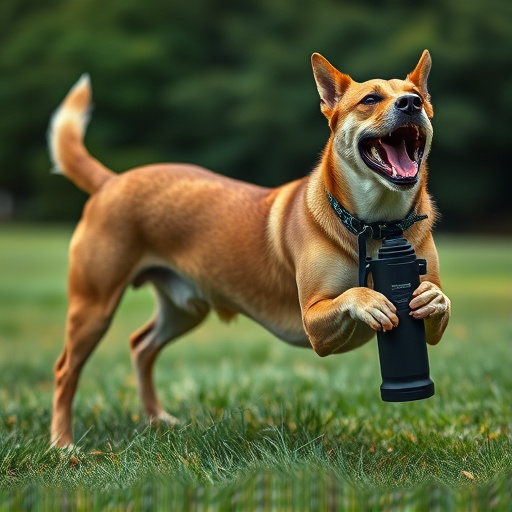Pepper spray exposure in dogs causes immediate distress, affecting eyes, nose, and respiratory system. To remove pepper spray from a dog's eyes, gently hold eyelids open and rinse with warm water for 15+ minutes. Severe irritation requires veterinary care. For safety, keep pepper spray out of pets' reach and use gentle, dog-safe eye decontaminants in emergencies.
“Discover the power of animal control pepper spray and its impact on dog behavior. This comprehensive guide explores how pepper spray works, specifically targeting canine eyes, and offers vital insights for immediate relief and long-term prevention. Learn about the effects, understand entry points, and master effective removal techniques to ensure your safety and that of your furry companions. We delve into proven solutions for removing pepper spray from dog eyes, offering practical steps to avoid future incidents.”
- Understanding Pepper Spray and Its Effects on Dogs
- How Pepper Spray Enters Dog Eyes
- Immediate Steps to Remove Pepper Spray from Dog Eyes
- Choosing the Right Pepper Spray Removal Solutions
- Preventive Measures to Avoid Future Incidents
Understanding Pepper Spray and Its Effects on Dogs
Pepper spray, a chemical agent designed to cause temporary blindness and severe discomfort, is a tool often employed by animal control professionals for crowd control and apprehending aggressive animals. When used on dogs, its effects can be immediate and potent. The spray irritates the dog’s eyes, nose, and respiratory system, leading to teary eyes, coughing, and difficulty breathing. These symptoms are meant to subdue the animal, allowing handlers to safely capture or relocate it without causing permanent harm.
Removing pepper spray from a dog’s eyes is a critical step after exposure. Due to its caustic nature, thorough rinsing with water is essential to flush out any residual spray. Gently holding the dog’s eyelids open and pouring water over its face for several minutes can help eliminate irritants. It’s important for pet owners and animal control officers alike to be aware of proper decontamination methods to ensure the well-being of both dogs and handlers after such encounters.
How Pepper Spray Enters Dog Eyes
Pepper spray, when used against dogs, enters their eyes through a complex mechanism. When the spray is released, tiny droplets containing capsaicin, the active ingredient, are propelled at high speeds towards the dog’s face. These droplets quickly adhere to the mucous membranes, including the eyes, and trigger a painful response by stimulating pain receptors. The eyes become irritated, causing them to water and close instinctively, a reaction designed to flush out and remove the irritant.
To effectively remove pepper spray from a dog’s eyes, it is crucial to act swiftly. Rinse the eyes thoroughly with a large amount of clean, warm water for at least 15 minutes. This helps to dilute and wash away the capsaicin. If available, use an eye lavage solution or saline to enhance the flushing process. After initial rinsing, gently wipe away any remaining residue using a soft cloth or towel. Seeking veterinary care is recommended if irritation persists or the dog exhibits signs of severe discomfort.
Immediate Steps to Remove Pepper Spray from Dog Eyes
If your dog has come into contact with animal control pepper spray, immediate action is crucial to ensure their comfort and safety. The first step is to remove any visible remnants of the spray from their fur and skin as quickly as possible. Start by rinsing the affected areas thoroughly with warm water; this can help dilute the pepper spray and prevent further irritation.
For the dog’s eyes, which are particularly sensitive, use a clean, damp cloth or cotton ball to gently wipe away any spray residue. Be mindful of the potential stinging sensation and avoid rubbing vigorously. If the eyes appear red, swollen, or if your dog is experiencing excessive tearing, consult a veterinarian for further guidance. They might recommend specific eye drops or ointments to alleviate discomfort and aid in the removal process.
Choosing the Right Pepper Spray Removal Solutions
When dealing with unwanted animal encounters, especially involving aggressive dogs, having pepper spray as a deterrent is essential. However, after such an incident, removing the pepper spray from your dog’s eyes becomes crucial for their safety and comfort. The right solution should be gentle yet effective in rinsing away the irritants.
Choosing the appropriate removal method is key; you’ll want to opt for a solution that’s specifically designed to neutralize pepper spray without causing further irritation. Mild, tear-free eye washes or solutions formulated for post-chemical exposure are ideal options. These products help flush out the pepper spray, providing immediate relief and preventing potential damage to sensitive eye tissues. Always ensure the product is safe for dogs and easily accessible in case of an emergency.
Preventive Measures to Avoid Future Incidents
Preventative measures are key in avoiding future incidents involving animal control pepper spray. If you have pets, it’s crucial to keep pepper spray out of reach and ensure they don’t have access to it. Regularly checking and securing storage areas is essential, especially if your pet has shown curiosity or attempted to access such substances in the past.
In case of accidental exposure, knowing how to remove pepper spray from a dog’s eyes is vital. Immediately rinse the affected area with plenty of water for at least 15 minutes, ensuring all traces of the spray are eliminated. This step can help prevent further irritation and discomfort for your pet.
Effective removal of pepper spray from a dog’s eyes is crucial to prevent discomfort and potential damage. Understanding how pepper spray interacts with canine eyes, taking immediate action, and using suitable removal solutions are essential steps. By following the right procedures and preventive measures, pet owners can ensure their dogs’ safety and comfort when faced with pepper spray exposure. Remember, knowing how to properly remove pepper spray from dog eyes is a valuable skill that can make all the difference in urgent situations.
